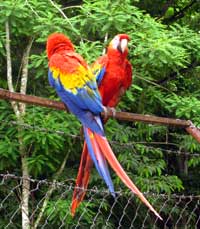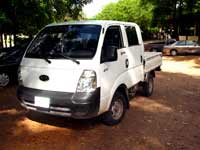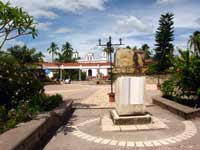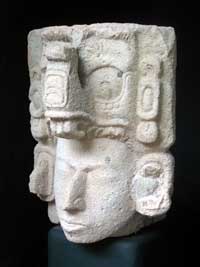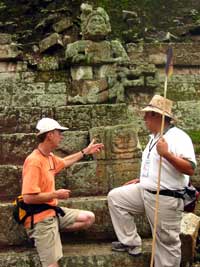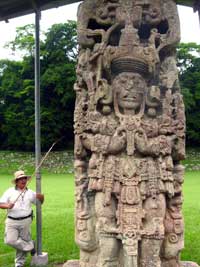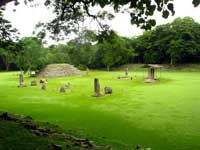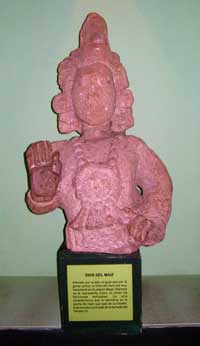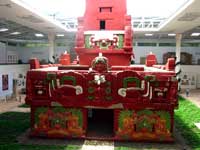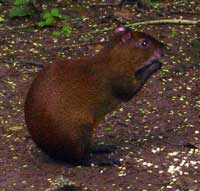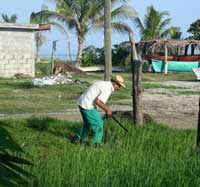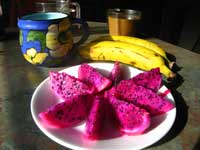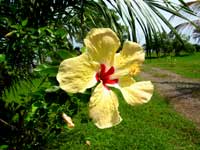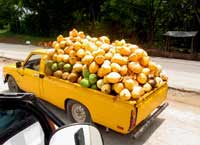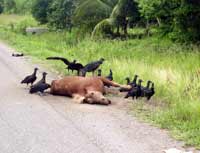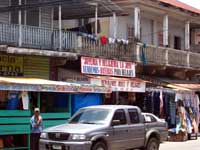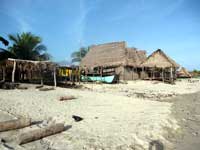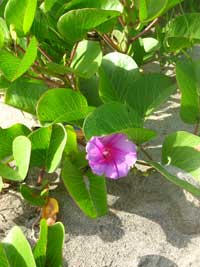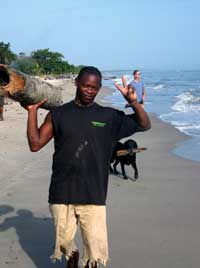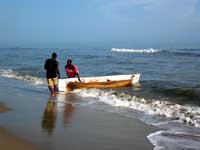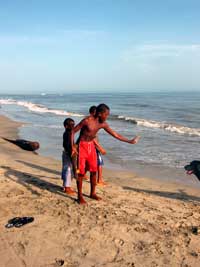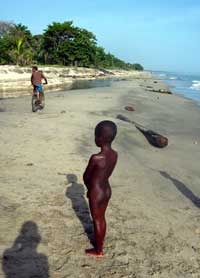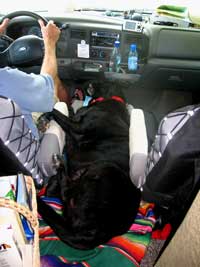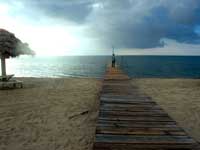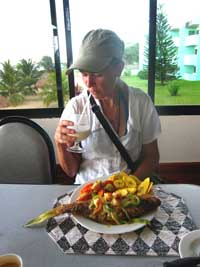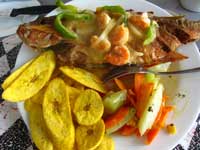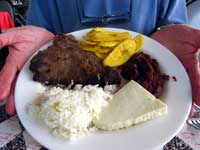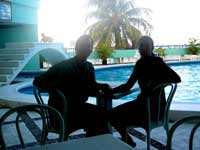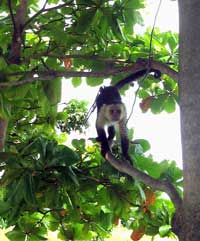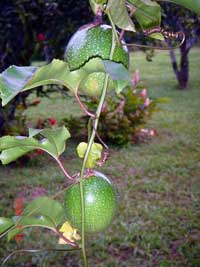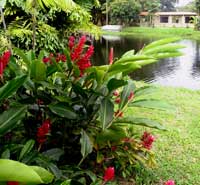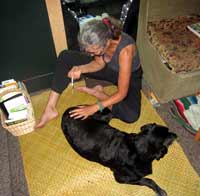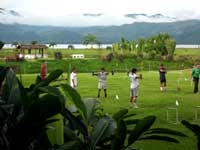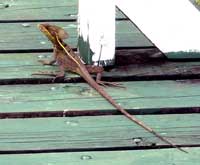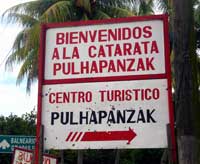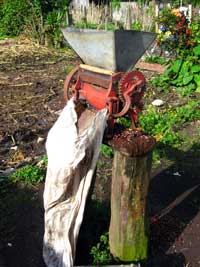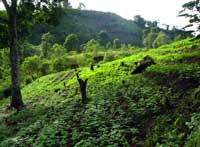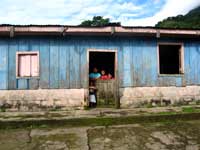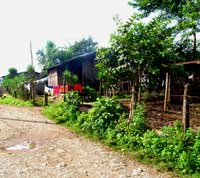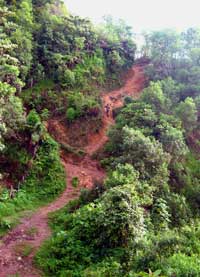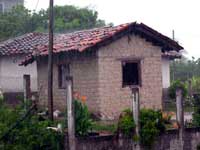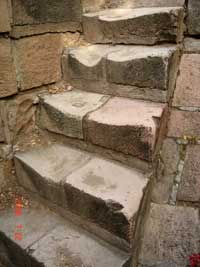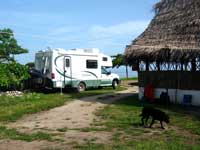

|
Difficulties with DOGS IN HONDURAS: |
|---|
This may not clear anything up for future travelers, but here's our experience, to add to the seemingly infinite number of variations on "official" policy: entering Honduras at El Florida, we were directed to Agricultura when we inquired about our dog. The Agricultura official wanted to know how long we’d be in the country. We told him we weren't’t sure, but up to 3 or 4 weeks, thinking we could get a longer temporary permit. He then told us that the law in Honduras requires all dogs entering the country to have a "cuarantena", not a true quarantine, but a document signed by a vet stating the animal is in good health, and processed by the federal government. Obviously, he said, we had not done this, so next he asked where we were going, and we told him Copan and then to the Caribbean coast, and he said excellent, we could present ourselves to Agricultura at the airport in La Ceiba, get our dog inspected at a local vet he gave us the name of, return to Agricultura with the vet and the cuarantena form, and we'd be good to go. He said to to negotiate with the vet. He wrote a letter to the Agricultura official in La Ceiba and made us sign it, in effect, promising to do this within six days of entering the country. He stamped our U.S.D.A. form, and we proceeded to Aduana for our automobile permits. He was considerate and helpful, gave us chairs and turned on the air conditioning while we waited. In fact, he was the friendliest and most personable of all the border officials. A few days later in La Ceiba, we drove to the airport, very near our beach camp at Pelican's Beat, and met with the Agricultura official. We were hoping we could pay the vet to meet us there with the form in hand, inspect Ziggy, fill out the form and hand it to the official. No such luck. The vet insisted we come to her office, and the fee was $100 US!! We debated whether to just skip the whole thing, especially since this Agricultura official said we'd have no trouble leaving the country without the cuarantena, only trouble staying, but decided in the end to show up at the vet's and bargain them down to, say, $50. If they went for it, we were willing to go through with it, and if not, we'd walk and take our chances. The vet in La Ceiba- actually his daughter, he was away on a trip-- spoke excellent English and apparently had her vet's degree, but wasn't yet licensed. She told us the process would take 15 days and the fee was not negotiable. We said we'd probably be out of the country by then, and we'd at least need a signed and stamped copy of the documents she'd be sending to the capitol to show that we'd complied with the law. She said that would not be possible, all copies had to be official ones. We asked what we could leave her office with to show we'd begun the process, and she said she couldn't give us anything. We then said, well, let's just get an exam and the vet's certificate of good health, which we thought would help us in Nicaragua and Costa Rica, and she said it wouldn't help as they wouldn't have an official stamp. Furthermore, she said, since we'd presented ourselves to her office, she was legally required to either complete the cuarentena with us, or notify Agricultura that we'd refused to do it, in which case the border authorities would be on alert for us and we couldn't leave the country with our dog! Additionally, the six-day window we were given to present ourselves to Agricultura did not constitute a six-day transit permit. Does the term "between a rock and a hard place" come to mind here? Another term comes to mind as well,, but we won't say it say it here! She called Agricultura once more for us, and they agreed to let us to have a signed copy of the cuarantena from the vet before they sent it off for processing. We waited a few hours in town for her father to return for his signature, but he was delayed at the airport, so we had to return the next morning. Our papers were ready the next day, stamped and signed, but we wanted to speak personally to the vet about the price of his services, and that we felt we'd been had, not only by him but by the whole cuarentena policy, when we knew of others who've been given transit permits. We won't go into the exchange, as it was very spirited and lengthly. Your Spanish gets a lot better when you're mad! The end result was that nothing changed. He was absolutely intransigent, telling us things we knew to be untrue. Both Agricultura officials had this vet's name; the one in La Ceiba Airport even had a stack of his business cards. We would recommend, if you can't avoid the cuarentena, using a different vet. For purposes of avoidance, his name is Dr. Sergio Reynel Bueno Ferrera, at the Bueno Hospital Veterinario, La Ceiba, Honduras. (No es Bueno!!) The official title of our hard-won document is Constancia de Cuarentena Fiduciaria, and they appear to be sequentially numbered. Ours is No. 0002, which makes us wonder how many this guy really writes! It's hard to know exactly what went wrong. In retrospect, we wish we hadn't even mentioned our dog at the border. There was no interior inspection of our rig, and even though she's a big lab and was sitting in the front seat, no one took any notice of her. We could have then taken our chances at the Nicaraguan border with our existing U.S.D.A. and Mexican Certificates of Health. We also considered shining the whole thing on and not even going to Agricultura at the La Ceiba airport, but after all, we'd signed a promise and felt an obligation to follow through. But if we'd known what was to follow, we probably would have just shined it, especially since we had the Honduran stamp on the U.S.D.A. Certificate of Health. Honduras is the first country we've had any dog troubles. Contrary to expectations, Mexico didn't care, even on the Mainland. And even on the Guatemalan border they told us, "Just one dog? You don't need anything." We think the best thing for entering Honduras would be to avoid the "cuarentena" like the plague, and instead press hard for a transit permit, since we know they exist. Perhaps our mistake was in asking for a longer period of time. When does the transit period end and the quarantina begin? We'd love to hear more details from those who've gotten gotten transit permits, maybe it would help the rest of us educate the Agricultura officials at the border that there's an alternative to the cuarentena. By the way, we love Honduras! |
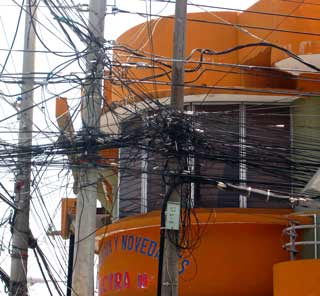 |
 Electric lines on streets in La Ceiba |
|---|
The Garifuna Village of Corozal
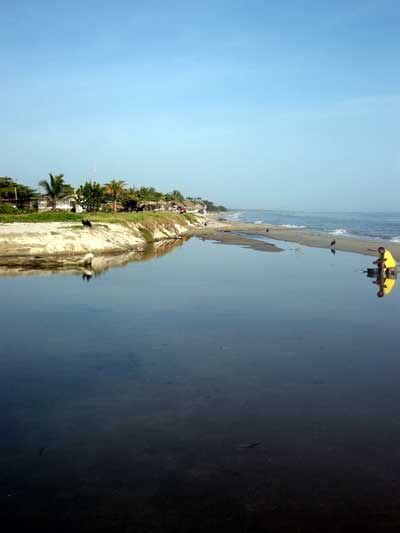 Since we'd be another day in La Ceiba getting Ziggy's papers we decided to spend the night on the beaches on the other side of town. We turned off the highway where we saw a restaurant sign, followed a dirt track down to the beach, where we found a small restaurant and hotel. We asked and the owner, a gruff-looking, old Garifuna man, said we could park alongside the restaurant. It was hot, so we changed into our suits and went for a swim and a walk on the beach. We were on the edge of Corozal, a Garifuna fishing village, and there were dugout canoes all along the beach, with hand-carved paddles. Most were for one or two people, but the largest, the "Titanic", was about 30' long and took six paddlers. They were beautifully made boats, carved by hand from a single section of tree trunk. The fishermen we talked to said they last 20 years or so, which was surprising since some of them look ancient, but they're used hard. The huge trees they're made from come from the inland mountains, and we were amazed there are still some left. The boat builder in the village takes orders, has the trunks delivered, then gets to work with his adz. He can finish a small canoa in about 20 days, and charges 4,000 Lempiras, or about $210. The "Titanic" cost 20,000 Lempira, or $1,050. In California he could sell them at double that price as planter boxes! The hulls of worn out or broken canoas are lying in front of the fishermen's homes, as if they just can't bear to get rid of them. Photo above: Corozal woman in yellow cleaning fish in the coolness of early morning
Since we'd be another day in La Ceiba getting Ziggy's papers we decided to spend the night on the beaches on the other side of town. We turned off the highway where we saw a restaurant sign, followed a dirt track down to the beach, where we found a small restaurant and hotel. We asked and the owner, a gruff-looking, old Garifuna man, said we could park alongside the restaurant. It was hot, so we changed into our suits and went for a swim and a walk on the beach. We were on the edge of Corozal, a Garifuna fishing village, and there were dugout canoes all along the beach, with hand-carved paddles. Most were for one or two people, but the largest, the "Titanic", was about 30' long and took six paddlers. They were beautifully made boats, carved by hand from a single section of tree trunk. The fishermen we talked to said they last 20 years or so, which was surprising since some of them look ancient, but they're used hard. The huge trees they're made from come from the inland mountains, and we were amazed there are still some left. The boat builder in the village takes orders, has the trunks delivered, then gets to work with his adz. He can finish a small canoa in about 20 days, and charges 4,000 Lempiras, or about $210. The "Titanic" cost 20,000 Lempira, or $1,050. In California he could sell them at double that price as planter boxes! The hulls of worn out or broken canoas are lying in front of the fishermen's homes, as if they just can't bear to get rid of them. Photo above: Corozal woman in yellow cleaning fish in the coolness of early morning
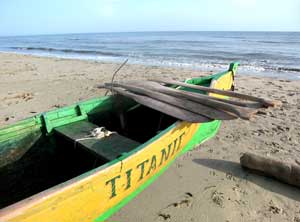
Garifunas are the descendants of slaves shipwrecked on their way to the New World, and have been in this region for hundreds of years. Some speak English, a few still speak their local Garifuna dialect, but most speak Spanish. They're a little more reserved than most other Hondurans we've met, except the kids, who are wild and free, sometimes naked, and don't seem to go to school much if at all. They know what they're going to be when they grow up.
As it was late afternoon when we took our walk, the wind was up, the sea choppy, and the surf was pounding pretty good. We'd noticed a single canoa far offshore with one man aboard, and wondered how he ever launched in this surf and how the hell he was ever going to get back 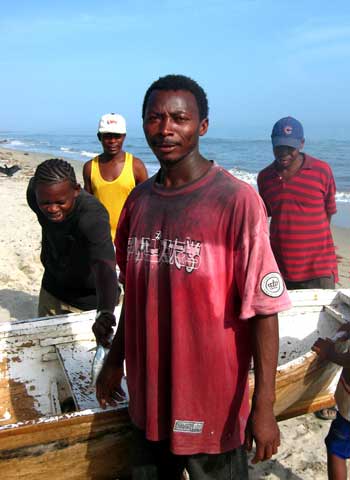 in. Paralleling the shoreline against the wind and the current, he was making good progress, when he turned and began paddling for the beach. It looked like we were about to find out how the hell he was ever going to get back in! He hung out like a surfer just beyond the breakers, then grabbed a big one and rode it into shore, bracing his paddle hard to stay straight, whooping with the thrill of it. We were awestruck. Rus ran up to help him pull his boat the last few yards to dry sand, but he must have accidentally got the heavy end; he could barely budge it, while this guy just picked his end up and carried it! He'd been a fisherman for 15 years, but hadn't even been fishing; it was his new boat, and he was just out for fun, to see what it could do! Next morning, we watched him come in again, this time through calm seas. Several others were there too, helped him pull his boat up, and waited while he divided up his catch among them, about 25 saltwater catfish 10-12" long. We can only imagine the complex relationships that weighed into how the fish was divvied up. From the deference paid to him, this man was obviously well-respected, and we were both struck by the power of his presence as well. He was man who seemed at home with himself, intelligent and capable, and full of life. Does it show in his picture?
in. Paralleling the shoreline against the wind and the current, he was making good progress, when he turned and began paddling for the beach. It looked like we were about to find out how the hell he was ever going to get back in! He hung out like a surfer just beyond the breakers, then grabbed a big one and rode it into shore, bracing his paddle hard to stay straight, whooping with the thrill of it. We were awestruck. Rus ran up to help him pull his boat the last few yards to dry sand, but he must have accidentally got the heavy end; he could barely budge it, while this guy just picked his end up and carried it! He'd been a fisherman for 15 years, but hadn't even been fishing; it was his new boat, and he was just out for fun, to see what it could do! Next morning, we watched him come in again, this time through calm seas. Several others were there too, helped him pull his boat up, and waited while he divided up his catch among them, about 25 saltwater catfish 10-12" long. We can only imagine the complex relationships that weighed into how the fish was divvied up. From the deference paid to him, this man was obviously well-respected, and we were both struck by the power of his presence as well. He was man who seemed at home with himself, intelligent and capable, and full of life. Does it show in his picture?
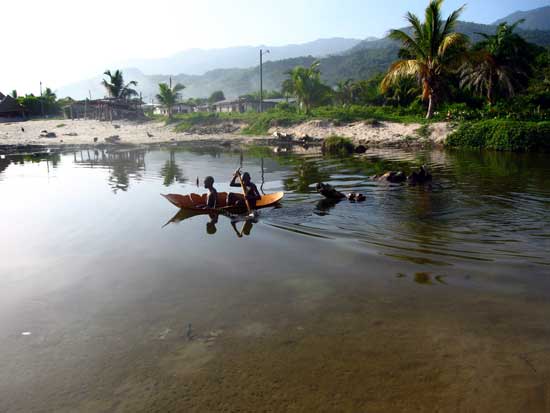
Morning lagoon ride in a scrap 'boat'

The fullness of life in this little Garifuna village was a powerful reminder of how little people really need. Though we've pared down a lot ourselves to make this journey, we still have so many more layers of material complexity to deal with than these folks do. Nothing they do takes very much equipment; they fish by hand in hand-made boats, they cook with wood, wash their dishes, clothes and themselves in the river, grow their own food in their gardens. They fish and do their work in the early morning, spending the heat of the day in the shade, hanging out together and watching the ocean a lot. They love music and dancing, look vibrant and healthy and we had many beautiful moments walking along the beach among them. We packed up and waved goodbye, refreshed and somehow changed by our time with the Garifuna in peaceful little Corozal.
Trujillo
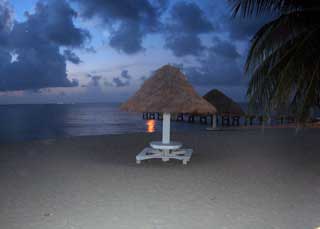 Trujillo is a little bigger town further east, on a protected stretch of coastline where we'd heard the beaches were perfect. It was 2 to 3 hours away, so off we went to check it out, and sure enough, the beaches were just about perfect; sandy bottom that stretched gradually out forever, gentle waves, no garbage, and no rip current, so you can come out where you went in. First order of business was finding a place to camp. We drove down a really bad dirt road parallel to the beach, couldn't find a thing, barely squeezed past an exposed concrete culvert, and were creeping back to a better road when a boy knocked on our window and told us we'd torn down a couple of wires back at his place. We pulled over and went back to take a look, and sure enough, the cable tv wires to two homes were lying on the ground. We'd caught them on our roof without even noticing as all our attention was on the road. A small crowd was quickly gathering; another kid said he'd go call the repairmen; we said we'd wait for them and pay for the repairs. We passed the time talking with a guy who'd floated over from Haiti several years before; Honduras and Venezuela were the only places that would accept him, so here he is today.
Trujillo is a little bigger town further east, on a protected stretch of coastline where we'd heard the beaches were perfect. It was 2 to 3 hours away, so off we went to check it out, and sure enough, the beaches were just about perfect; sandy bottom that stretched gradually out forever, gentle waves, no garbage, and no rip current, so you can come out where you went in. First order of business was finding a place to camp. We drove down a really bad dirt road parallel to the beach, couldn't find a thing, barely squeezed past an exposed concrete culvert, and were creeping back to a better road when a boy knocked on our window and told us we'd torn down a couple of wires back at his place. We pulled over and went back to take a look, and sure enough, the cable tv wires to two homes were lying on the ground. We'd caught them on our roof without even noticing as all our attention was on the road. A small crowd was quickly gathering; another kid said he'd go call the repairmen; we said we'd wait for them and pay for the repairs. We passed the time talking with a guy who'd floated over from Haiti several years before; Honduras and Venezuela were the only places that would accept him, so here he is today.
 Luckily the repair guys came within a few minutes, quickly got their ladders out and reconnected the wires, and were about to drive off when we asked them what the bill was. They shrugged and said nothing, it was only 35 Lempiras worth of wire and materials, not to bother. We gave them 50 Lempiras anyway, about $2.50, and made our way back the way we came, feeling lucky not to have caused a town-wide blackout and electrocuted ourselves for good measure. But we weren't quite as lucky we thought; one of our tires had caught on the edge of the culvert we'd squeezed by and tore a big chunk out of the sidewall. It was ruined. We were thankful we'd brought two mounted spares!
Luckily the repair guys came within a few minutes, quickly got their ladders out and reconnected the wires, and were about to drive off when we asked them what the bill was. They shrugged and said nothing, it was only 35 Lempiras worth of wire and materials, not to bother. We gave them 50 Lempiras anyway, about $2.50, and made our way back the way we came, feeling lucky not to have caused a town-wide blackout and electrocuted ourselves for good measure. But we weren't quite as lucky we thought; one of our tires had caught on the edge of the culvert we'd squeezed by and tore a big chunk out of the sidewall. It was ruined. We were thankful we'd brought two mounted spares!
Outside a small hotel a guy saw our rig and came quickly out, excited, speaking English. He was an Australian and explained his plight to us: he'd been working for Habitat for Humanity and doing evangelical mission work, but got beat up and robbed by the police in the capitol. He'd wired his parents for money, but it would be a couple of days until the funds arrived. He appeared to be drunk but didn't smell of alcohol, the fuzziness could have been from his head injury after all. The people at the hotel were extending him credit for his room and meals, but he needed to get some clothes and toiletries, as he'd lost everything he owned. Oh, and he was dying of cancer, given just 6 months to live. The part we believed was that he wanted some money, so we gave him enough to buy a toothbrush, but not more drugs, and one of Rus' shirts. He was visibly disappointed.
 We got back to the highway and drove up to a place we'd seen on the way into town, the Christopher Columbus Hotel, right on the beach, with pools, restaurant, bar, and tennis courts. We parked, walked up to the desk and asked if we might have permission to stay there for a couple of days and use their facilities. The lady was very polite and said the manager was out, but would be back later. We said fine, we'd be in the restaurant and would check back later, and got permission to leave our rig where it was until then. When we did, the manager still hadn't come, and that's where we left it- for two days and two nights. We had dinner and drinks each night in their restaurant, hung out on their beach, used their outdoor showers, and finally we left, not wanting to say good-bye because we weren't officially even there! Many workers here have no desire to make a decision about something that's outside of the ordinary. They don't have the authority to say yes and can't stand to say no, so that's where it stays, in a kind of no-man's-land. It's just the kind of thing that drives Americans crazy, but we're starting to get used to it. The third night, we drove over to a neighboring beachfront restaurant and got the same treatment, but finally did get permission after several hours.
We got back to the highway and drove up to a place we'd seen on the way into town, the Christopher Columbus Hotel, right on the beach, with pools, restaurant, bar, and tennis courts. We parked, walked up to the desk and asked if we might have permission to stay there for a couple of days and use their facilities. The lady was very polite and said the manager was out, but would be back later. We said fine, we'd be in the restaurant and would check back later, and got permission to leave our rig where it was until then. When we did, the manager still hadn't come, and that's where we left it- for two days and two nights. We had dinner and drinks each night in their restaurant, hung out on their beach, used their outdoor showers, and finally we left, not wanting to say good-bye because we weren't officially even there! Many workers here have no desire to make a decision about something that's outside of the ordinary. They don't have the authority to say yes and can't stand to say no, so that's where it stays, in a kind of no-man's-land. It's just the kind of thing that drives Americans crazy, but we're starting to get used to it. The third night, we drove over to a neighboring beachfront restaurant and got the same treatment, but finally did get permission after several hours.
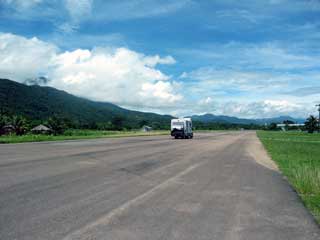 Next to the hotel we'd parked in was Trujillo's landing strip, built for large jets, with a rusting control tower, way out of proportion to the size of the town. When we asked our waiter at the Christopher Columbus about it, he said it was built by the government, and was already there a few years before the hotel was built in the early '90's. Hmmm.... wasn't that about the time the U.S. was using Honduras as a staging area to supply the Contra rebels in Nicaragua? We'd heard rumors this was one of airstrips they funded, but the only thing we know for sure is that Trujillo has lots of growing to do before it would need a strip like this one! No wonder Americans don't travel very much in Latin America; it's too embarrassing.
Next to the hotel we'd parked in was Trujillo's landing strip, built for large jets, with a rusting control tower, way out of proportion to the size of the town. When we asked our waiter at the Christopher Columbus about it, he said it was built by the government, and was already there a few years before the hotel was built in the early '90's. Hmmm.... wasn't that about the time the U.S. was using Honduras as a staging area to supply the Contra rebels in Nicaragua? We'd heard rumors this was one of airstrips they funded, but the only thing we know for sure is that Trujillo has lots of growing to do before it would need a strip like this one! No wonder Americans don't travel very much in Latin America; it's too embarrassing.
We'd been looking for two days at a point of land in the the distance, the Cabo de Honduras, where we'd heard all the fruit was shipped out of Honduras, and decided to investigate early on the morning we left Trujillo. Before we even got to the port, we came to a security gate, with several guards, not the usual mustered out ex-soldiers with shotguns, but young alert guys armed to the teeth with paramilitary weaponry, the kind of people you'd want if you were going to take over a country. We weren't expecting this kind of security, but once we were there, we couldn't just cut and run. After checking us over good, they said we could proceed to the next gate, but to tell them we were tourists and wanted to just look. We drove alongside the port behind a high-security fence, a huge operation that said Dole everywhere you looked.
 A couple of miles ahead we came to the next gate, which turned out to be a Honduran military base, with even more guards and ordinance than at the first gate. We didn't plan to go onto a military base sightseeing, but here we were, and it didn't seem right to turn back now after getting this far. We said we were American tourists, and had come to see what there was to see. They were clearly nonplussed, never having to deal with a situation like this before. But in the military, it's easy: you just run it up the chain of command. We hung out with the soldiers, showed them our rig, they showed us their pet monkey, and chatted while others went to see higher-ups and talked by radio to get us clearance. We've been in these situations before, where simple curiosity leads us to a place where there is no protocol for visitors. It's not that important to us whether we gain access, but Rus finds it fascinating to watch the process unfold. Plus we're aware of our entertainment value for these guys, who may not see another person for hours, and certainly not another foreigner.
A couple of miles ahead we came to the next gate, which turned out to be a Honduran military base, with even more guards and ordinance than at the first gate. We didn't plan to go onto a military base sightseeing, but here we were, and it didn't seem right to turn back now after getting this far. We said we were American tourists, and had come to see what there was to see. They were clearly nonplussed, never having to deal with a situation like this before. But in the military, it's easy: you just run it up the chain of command. We hung out with the soldiers, showed them our rig, they showed us their pet monkey, and chatted while others went to see higher-ups and talked by radio to get us clearance. We've been in these situations before, where simple curiosity leads us to a place where there is no protocol for visitors. It's not that important to us whether we gain access, but Rus finds it fascinating to watch the process unfold. Plus we're aware of our entertainment value for these guys, who may not see another person for hours, and certainly not another foreigner.
A 15 minutes later, we were cleared for entry onto the base, an armed escort riding shotgun, while Kathleen sat behind. When we reached the end of the cape, between a naval dock and a barracks, our escort told us where to park and was explicit in telling us where we could and couldn't go. Then he left us and walked back. Before us, between the dock and barracks, we were surprised to find the beautiful cove of the Bay of Trujillo, with crystal clear 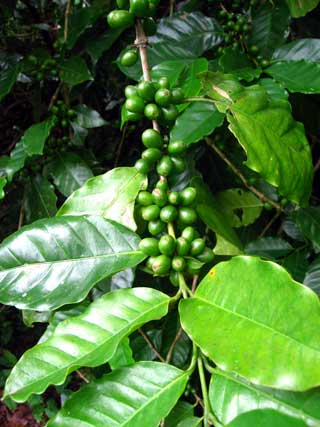 water, fine sand, not a soul around. We changed into our suits, made for the water, and and all three of us had a good swim. That was the extent of our security clearance onto the military base.
water, fine sand, not a soul around. We changed into our suits, made for the water, and and all three of us had a good swim. That was the extent of our security clearance onto the military base.
But the oppressive heat and humidity got to us, aided by the biting insects. We had welts all over our bodies, Ziggy was scratching constantly and developing hot spots, so it was time to head for higher ground. We turned inland, headed toward Lago de Yajoa, a giant freshwater lake in the northwest quadrant of the Honduras . We drove a mostly dirt road through some of most beautiful ranch land we've seen so far. Driving through the land, everywhere we've been, has been one of the greatest pleasures of this trip, like an Imax movie that pauses when we stop, and continues when we start rolling again. Even the impossible jammed traffic situations are fascinating, now that we've learned to have faith, just watch them unfold, not knowing how in the hell we're going to get through this time, but knowing that we probably will. Photo above: green coffee beans growing on the bush
Lago de Yojoa
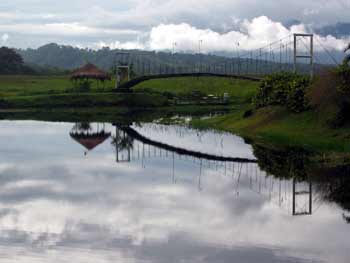 We arrived a couple of days later at Lago Yojoa, and what a natural beauty it is, about 17km long and 8km wide, ringed by mountains, wide marshes, with very little development on its shores, and lots of exotic waterfowl and shorebirds. The manager at our last fuel stop recommended Las Glorias, a resort on the more remote west side of the lake. We asked if we could park there for a couple of nights, and they said, as usual, the manager's not in right now, but we can ask her when she returns. We walked around the grounds and lakefront for an hour or so, checking out the pool, orchards and dock, and when we returned to the office the manager was in, and said we could park next to their boat ramp with a fantastic view of the lake for a very reasonable charge. We found it often helps if we stress that we're self-contained and don't need anything, except maybe some water, and that we intend to eat in their restaurant. Rus' dinner was so delicious, he ordered it again the next night; pescado entero, a whole tilapia from the lake, scored deeply on the sides, dredged in flour and deep fried. It's so good, you eat the fins and tail like potato chips!
We arrived a couple of days later at Lago Yojoa, and what a natural beauty it is, about 17km long and 8km wide, ringed by mountains, wide marshes, with very little development on its shores, and lots of exotic waterfowl and shorebirds. The manager at our last fuel stop recommended Las Glorias, a resort on the more remote west side of the lake. We asked if we could park there for a couple of nights, and they said, as usual, the manager's not in right now, but we can ask her when she returns. We walked around the grounds and lakefront for an hour or so, checking out the pool, orchards and dock, and when we returned to the office the manager was in, and said we could park next to their boat ramp with a fantastic view of the lake for a very reasonable charge. We found it often helps if we stress that we're self-contained and don't need anything, except maybe some water, and that we intend to eat in their restaurant. Rus' dinner was so delicious, he ordered it again the next night; pescado entero, a whole tilapia from the lake, scored deeply on the sides, dredged in flour and deep fried. It's so good, you eat the fins and tail like potato chips!
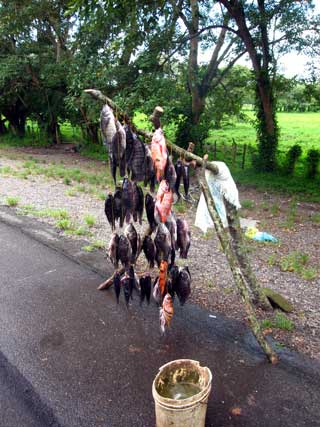 Ziggy was going downhill. She was listless except for scratching and chewing on herself constantly, and her hot spots were getting worse, infected and pussy. The day before, we'd stopped at a veterinary supply store for large animals to buy an antibiotic/anti-inflammatory and a syringe, and decided we'd better give it to her. Administering drugs, to yourself or your animals down here, works like this: you go to to the pharmacy or veterinary supply, explain your problem, and they give you drugs you could only get in the U.S. by prescription. It's also amazingly inexpensive, about $3.50 for this one. The instructions said not to administer the injection if we planned to eat the animal within 30 days. No problem there, but next we had to figure out the total volume of the two-part injection in IU's, calculate the dosage for Ziggy's weight in kilograms, convert IU's to CC's, then give her the injection, IM. Luckily Kathleen used to be a nurse, but it had been a while. By that evening, Ziggy was improved, and within two days she was back to normal, guarding her territory and begging food from strangers. Photo:Tilapia for sale along the lakeside
Ziggy was going downhill. She was listless except for scratching and chewing on herself constantly, and her hot spots were getting worse, infected and pussy. The day before, we'd stopped at a veterinary supply store for large animals to buy an antibiotic/anti-inflammatory and a syringe, and decided we'd better give it to her. Administering drugs, to yourself or your animals down here, works like this: you go to to the pharmacy or veterinary supply, explain your problem, and they give you drugs you could only get in the U.S. by prescription. It's also amazingly inexpensive, about $3.50 for this one. The instructions said not to administer the injection if we planned to eat the animal within 30 days. No problem there, but next we had to figure out the total volume of the two-part injection in IU's, calculate the dosage for Ziggy's weight in kilograms, convert IU's to CC's, then give her the injection, IM. Luckily Kathleen used to be a nurse, but it had been a while. By that evening, Ziggy was improved, and within two days she was back to normal, guarding her territory and begging food from strangers. Photo:Tilapia for sale along the lakeside
A professional soccer team, about 30 players plus coach and support staff, was using the resort to train for an upcoming tournament, and they set themselves up in the large field next to us, on the lakefront. We had fun watching them doing their exercises, weights, laps, hurdles, playing volleyball using only their feet and heads, and most of all watching the goalies practicing. These guys would just dive for the ball, whatever it took to block it, pick themselves up, and do it again and again. They were the most skilled players we'd ever seen, and their energy, spirit, and comradeship was inspiring to be around. We thought they might be the national team to have merited training here, but found out they weren't even a top-level team. Still, they had a couple of stars, and the press was there filming and doing interviews.
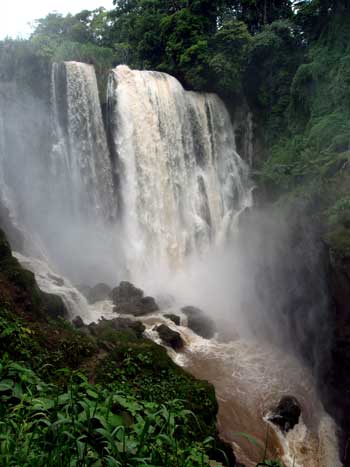 Catarata Pulhapanzak
Catarata Pulhapanzak
Leaving beautiful Lago de Yajoa, we visited Honduras' largest waterfall, Las Cataratas de Pulhapanzak, which, from the deluge the night before, was a slippery hike to the 43-meter wall of muddy water, Ziggy straining at her leash to get into it. Soaked with mist and sweat, we made it back to the rig and drove to our last planned destination here, lunch at the D&D Brewery outside nearby Pena Blanca, owned by an actual American. We found a place to park, went to the restaurant and ordered good sandwiches and good beer, two things we thought we'd left far behind. The owner, an ex patriot from Timber, Oregon named Robert Dale, put some good music on the stereo, Jerry Garcia with David Grisman, then came and sat with us while we ate. Bob started his business about three years ago, which also includes a few clean and charming cabins for rent and a pool, as well as the brewery and restaurant, though he's owned the land for longer. He married a Honduran; she and their kids had left the day before for Copan, where they also have a place. Turns out his wife is the first cousin of our friend Flavia in Copan!
 Bob took a few hours from his many projects to show us around his place. He's planted dozens of varieties of exotic tropical plants on the land, most tended lovingly, others just growing wild. There are many varieties of orchids, ginger, heliconia, flowering banana, as well as other fruits and berries, and coffee, as the land used to be a coffee finca. He has a vast knowledge of how the native plants were used, and are still, by the indigenous peoples for food, medicine, tools and adornment. We have never tasted so many things we'd never tried before that were so delicious, just walking around Bob's property with him and popping things he gave us into our mouths, such as cinnamon leaf and begonia flowers! Since the climate is so warm, his brewery is an insulated 40' refrigerated shipping container with a stainless steel interior, spotlessly clean and plenty large for the scale of his operation. He also brews all of his soft drinks; his root beer is the best we've ever had, naturally made from plants growing on the property.
Bob took a few hours from his many projects to show us around his place. He's planted dozens of varieties of exotic tropical plants on the land, most tended lovingly, others just growing wild. There are many varieties of orchids, ginger, heliconia, flowering banana, as well as other fruits and berries, and coffee, as the land used to be a coffee finca. He has a vast knowledge of how the native plants were used, and are still, by the indigenous peoples for food, medicine, tools and adornment. We have never tasted so many things we'd never tried before that were so delicious, just walking around Bob's property with him and popping things he gave us into our mouths, such as cinnamon leaf and begonia flowers! Since the climate is so warm, his brewery is an insulated 40' refrigerated shipping container with a stainless steel interior, spotlessly clean and plenty large for the scale of his operation. He also brews all of his soft drinks; his root beer is the best we've ever had, naturally made from plants growing on the property.
When Bob first began living in Honduras full-time six years ago, he made his living building swimming pools, and in the process has uncovered some impressive Mayan artifacts. His knowledge of the ancient Mayans is extensive, owing to his curiosity and a close friendship with one of the Copan archeologists. Most interesting was a roller for making paper and its accompanying concave base with an ornamental carved harpie's head. It looks like the stones the Mayans use for grinding corn, but far more refined. Both were in perfect condition, except for a small ding on the base's underside, where his shovel found it. The fit and polish of both pieces was so perfect, the roller would roll back and forth for nearly 3 minutes when released at one end of the base. When Kathleen plucked one of her very fine hairs and placed it in its path, it made a very audible "tic...tic" as it rolled back and forth over the hair, so exact was the fit between the two stones.
In Search of a Cloud Forest
 Finally taking our leave from D&D Brewery in the late afternoon, loaded with green coffee and blueberries from Bob's finca and some seeds from his garden to plant when we get home, we got on the road again, but only a few miles. We decided to go see the Parque National de Santa Barbara, with its virgin cloud forest, since we were so close. The park is protected, but not set up for tourism, and we were warned the road there is really bad, especially in rainy season. Using our "connection" with Bob, who had built their pools, we talked our way into the Campamento Armadillo, a place that had never opened its gates to a private camper before, only a mile or so from the road leading to the park. They do groups only, for some reason.
Finally taking our leave from D&D Brewery in the late afternoon, loaded with green coffee and blueberries from Bob's finca and some seeds from his garden to plant when we get home, we got on the road again, but only a few miles. We decided to go see the Parque National de Santa Barbara, with its virgin cloud forest, since we were so close. The park is protected, but not set up for tourism, and we were warned the road there is really bad, especially in rainy season. Using our "connection" with Bob, who had built their pools, we talked our way into the Campamento Armadillo, a place that had never opened its gates to a private camper before, only a mile or so from the road leading to the park. They do groups only, for some reason.
Next morning we rose at 6:00, got the moto ready, left Ziggy in the rig with the fans on and took off. The road was even worse than we'd been warned. There was no way we could have driven the rig, and it even challenged the moto in places, with large sharp rocks, ruts, mud and washouts. We climbed up through jungle, groves of banana, cornfields, opening to gorgeous views of Lago de Yojoa on one side, and the village of Pena Blanca on the other, far below. We were on our way to a place that had never been touched by an axe or hoe, and we were excited.
 Rounding a bend in the "road", we were surprised to see a couple of mud and stick homes, and kids in their school uniforms, walking up the road. Why up? Shouldn't they be going down, to Pena Blanca? But then we saw more homes, more kids heading up, plus men walking with their tools, and women carrying their pails of maize to grind for the day. In the middle of nowhere with no way to get there, here was a village! People stopped what they were doing and stared at us in wonderment. Kathleen waved at everyone, and they waved back. Some cried out to us. We came to the school; it was abuzz as the day's activities got under way. It was just a tiny village, and we were through it in no time, but soon we came to another, larger village, and even more surprising, a yellow bus! Its engine was running, and people were milling around. How did it get there, and where was it going? It couldn't have come up the way we had, and there was nowhere to go. But we found out it did, twice a day, so people in these tiny villages could go down to do their business, sell their produce, and return by afternoon. It's hard to do justice in words to the state of that road; our incredulity will have to do, that a surplus American schoolbus could make it up, and down, as a matter of routine. Our hats are off to that driver, as they are to so many of the bus drivers in this part of the world.
Rounding a bend in the "road", we were surprised to see a couple of mud and stick homes, and kids in their school uniforms, walking up the road. Why up? Shouldn't they be going down, to Pena Blanca? But then we saw more homes, more kids heading up, plus men walking with their tools, and women carrying their pails of maize to grind for the day. In the middle of nowhere with no way to get there, here was a village! People stopped what they were doing and stared at us in wonderment. Kathleen waved at everyone, and they waved back. Some cried out to us. We came to the school; it was abuzz as the day's activities got under way. It was just a tiny village, and we were through it in no time, but soon we came to another, larger village, and even more surprising, a yellow bus! Its engine was running, and people were milling around. How did it get there, and where was it going? It couldn't have come up the way we had, and there was nowhere to go. But we found out it did, twice a day, so people in these tiny villages could go down to do their business, sell their produce, and return by afternoon. It's hard to do justice in words to the state of that road; our incredulity will have to do, that a surplus American schoolbus could make it up, and down, as a matter of routine. Our hats are off to that driver, as they are to so many of the bus drivers in this part of the world.
 This was the end of the line for us, as well. The road forked, went down a rat hole to the right, and into a gully on the left. Some villagers told us to follow the trail up to the mountain, so we left the moto where the left fork ended and continued on foot. We don't worry about it being stolen in places like these. Everyone would know who stole it: he'd be the guy with the motorcycle! As we climbed along the very steep, slippery trail, sometimes several feet deep from rain and years of horse and foot traffic, we looked up at the mountain, where the farmland stopped and the forest began, where it disappeared into the clouds. It was a long way off. We'd thought for some reason the road went to the park, but it became clear we had at least a two-hour push ahead of us to even get to the edge. And then we had to come down, too, without getting ourselves lost. We made the best decision of our lives and stopped after a half hour or so, took some pictures, and climbed back down the path to our moto. By the time we started back down the road, people in the village had been alerted to our presence. We shifted into low gear to enjoy the show in slow motion. Heads appeared at every door and window as we passed; we all smiled and waved at each other, hollering out "Hola!" and "Buenas!" (Hondurans often omit the dias, tardes, or noches from the "buenas"), stopping sometimes to take a photo or two which they delighted to see on the back of the camera. It was so much fun, we felt like rock stars.
This was the end of the line for us, as well. The road forked, went down a rat hole to the right, and into a gully on the left. Some villagers told us to follow the trail up to the mountain, so we left the moto where the left fork ended and continued on foot. We don't worry about it being stolen in places like these. Everyone would know who stole it: he'd be the guy with the motorcycle! As we climbed along the very steep, slippery trail, sometimes several feet deep from rain and years of horse and foot traffic, we looked up at the mountain, where the farmland stopped and the forest began, where it disappeared into the clouds. It was a long way off. We'd thought for some reason the road went to the park, but it became clear we had at least a two-hour push ahead of us to even get to the edge. And then we had to come down, too, without getting ourselves lost. We made the best decision of our lives and stopped after a half hour or so, took some pictures, and climbed back down the path to our moto. By the time we started back down the road, people in the village had been alerted to our presence. We shifted into low gear to enjoy the show in slow motion. Heads appeared at every door and window as we passed; we all smiled and waved at each other, hollering out "Hola!" and "Buenas!" (Hondurans often omit the dias, tardes, or noches from the "buenas"), stopping sometimes to take a photo or two which they delighted to see on the back of the camera. It was so much fun, we felt like rock stars.
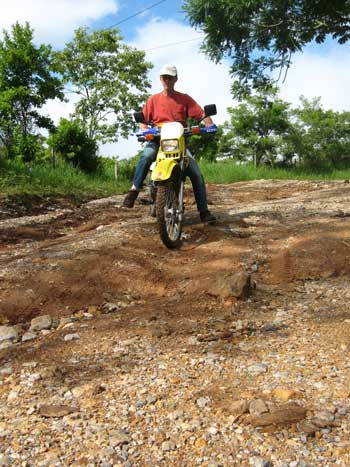 We have to mention that people in Honduras have been exceptionally friendly, and hospitable. Our main form of excercise here has been waving. Hondurans are proud of their country, want to know where we've been, where we're going next, what we think of the place, and are full of suggestions and tips of what to do and see. They are also exceedingly polite, more than anywhere else we've been. Even after the most casual encounter, a Honduran will ask your permission to leave. If you're eating in a restaurant and someone entering walks by your table, they'll say "Buen provecho!" (good appetite). The police, too, have been extremely helpful. For example, on his way into Choluteca on the moto to get a fuel leak fixed, Rus was flagged down for not wearing a helmet. The officer seemed ready to write a ticket, when Rus said he came into town to find a mechanic. The officer said there were a couple in town, but didn't know where, so he flagged down a passing motorcycle cop, who also gave an admonishment about the helmet, then said "Follow me", and led him through town, down unpaved side streets, to a place he'd never have found if he'd been wearing his helmet. The officer hung out for nearly an hour, visiting with the mechanic and his family and making sure everything was going to be ok, before shaking hands and taking his leave. The mechanic worked for nearly two hours, including a parts run (the fuel valve membrane had perforated) and charged $100 Lempira, about $5.00. Then he insisted on riding back to the rig with Rus so he wouldn't get stopped again, an employee following on another moto to take him back. Not a helmet among them, and the police were waving and greeting them the whole way back. Go figure.
We have to mention that people in Honduras have been exceptionally friendly, and hospitable. Our main form of excercise here has been waving. Hondurans are proud of their country, want to know where we've been, where we're going next, what we think of the place, and are full of suggestions and tips of what to do and see. They are also exceedingly polite, more than anywhere else we've been. Even after the most casual encounter, a Honduran will ask your permission to leave. If you're eating in a restaurant and someone entering walks by your table, they'll say "Buen provecho!" (good appetite). The police, too, have been extremely helpful. For example, on his way into Choluteca on the moto to get a fuel leak fixed, Rus was flagged down for not wearing a helmet. The officer seemed ready to write a ticket, when Rus said he came into town to find a mechanic. The officer said there were a couple in town, but didn't know where, so he flagged down a passing motorcycle cop, who also gave an admonishment about the helmet, then said "Follow me", and led him through town, down unpaved side streets, to a place he'd never have found if he'd been wearing his helmet. The officer hung out for nearly an hour, visiting with the mechanic and his family and making sure everything was going to be ok, before shaking hands and taking his leave. The mechanic worked for nearly two hours, including a parts run (the fuel valve membrane had perforated) and charged $100 Lempira, about $5.00. Then he insisted on riding back to the rig with Rus so he wouldn't get stopped again, an employee following on another moto to take him back. Not a helmet among them, and the police were waving and greeting them the whole way back. Go figure.
Choluteca
 We spent a couple of nights in Choluteca parked in the lot of the very fancy Hacienda Gualiqueme. We'd heard they had wireless internet, which we love because we can be online in our rig instead of spending hours in an internet cafe, but it wasn't functioning because of a recent storm. When we arrived, the pool area was crowded with people, most of them Americans! Rus talked to a couple, and found they were a group of evangelical Christians who were visiting Honduras on a "mission". There were over 60 of them, mostly young people in their late teens or early twenties, accompanied by a good number of chaperones. A couple of the adults spoke a little Spanish but the group had translators. They'd been in the country about a week, and were leaving the next day to spend a couple of days in El Salvador before flying home. In the morning a huge tour bus drove up, and while he waited in the parking lot (our camp) the bus driver chatted with us. He was a local and a born again Christian. Kathleen asked him why he thought so many Hondurans were leaving Catholicism for the Fundamental churches and he replied that the Catholic Church was too easy. It looked the other way if people drank too much and sinned or didn't follow the rules. People needed a stronger discipline to keep them on track and the Protestant churches gave it to them. This also kept many people away though, he said. The tithing of 10% of wages earned was more than some were able or willing to agree to. Once the bags were loaded and all the missionaries had finally climbed on board, the big shiny bus headed off toward El Salvador and another nice hotel.
We spent a couple of nights in Choluteca parked in the lot of the very fancy Hacienda Gualiqueme. We'd heard they had wireless internet, which we love because we can be online in our rig instead of spending hours in an internet cafe, but it wasn't functioning because of a recent storm. When we arrived, the pool area was crowded with people, most of them Americans! Rus talked to a couple, and found they were a group of evangelical Christians who were visiting Honduras on a "mission". There were over 60 of them, mostly young people in their late teens or early twenties, accompanied by a good number of chaperones. A couple of the adults spoke a little Spanish but the group had translators. They'd been in the country about a week, and were leaving the next day to spend a couple of days in El Salvador before flying home. In the morning a huge tour bus drove up, and while he waited in the parking lot (our camp) the bus driver chatted with us. He was a local and a born again Christian. Kathleen asked him why he thought so many Hondurans were leaving Catholicism for the Fundamental churches and he replied that the Catholic Church was too easy. It looked the other way if people drank too much and sinned or didn't follow the rules. People needed a stronger discipline to keep them on track and the Protestant churches gave it to them. This also kept many people away though, he said. The tithing of 10% of wages earned was more than some were able or willing to agree to. Once the bags were loaded and all the missionaries had finally climbed on board, the big shiny bus headed off toward El Salvador and another nice hotel.
 It was time to leave Honduras for Nicaragua. We hadn't driven much on CA1, the Pan American Highway, and decided to take it to the border, especially since it was hot as hell and CA1 looked like a cooler route. We climbed to 3,000 ft quickly and stayed there for a good part of the drive, through green mountains and long vistas. A mile or so from the border, we crested a hill and swerved to avoid a traffic cone placed slightly into our lane, followed by a police checkpoint. The officer motioned us to stop, so we pulled over and waited. He asked for Rus' license, informed him that he'd knocked over a traffic cone, and would have to pay a fine. Rus looked back, saw that indeed the cone was on its side, and said to the cop,"Give me a ticket, then", and walked over to set the cone upright. He was getting mad, but for once decided to keep his mouth shut. He ignored the cop and asked Kathleen to come back with her camera and take a photo of the crime scene, with the cone in our lane, which we did, with a bit of drama. When we returned, the cop had changed his mind, handed Rus back his license, shook his hand and wished us a safe trip. Little by little we're learning the game.
It was time to leave Honduras for Nicaragua. We hadn't driven much on CA1, the Pan American Highway, and decided to take it to the border, especially since it was hot as hell and CA1 looked like a cooler route. We climbed to 3,000 ft quickly and stayed there for a good part of the drive, through green mountains and long vistas. A mile or so from the border, we crested a hill and swerved to avoid a traffic cone placed slightly into our lane, followed by a police checkpoint. The officer motioned us to stop, so we pulled over and waited. He asked for Rus' license, informed him that he'd knocked over a traffic cone, and would have to pay a fine. Rus looked back, saw that indeed the cone was on its side, and said to the cop,"Give me a ticket, then", and walked over to set the cone upright. He was getting mad, but for once decided to keep his mouth shut. He ignored the cop and asked Kathleen to come back with her camera and take a photo of the crime scene, with the cone in our lane, which we did, with a bit of drama. When we returned, the cop had changed his mind, handed Rus back his license, shook his hand and wished us a safe trip. Little by little we're learning the game.

We love Honduras!
| Camp Sites we found in Honduras |
|---|
COPAN Hacienda San Lucas, Copan The place is beautiful and tastefully remodeled in the tradition of the original hacienda. Landscaped with flowers, large shade trees and lawns, wooden benches invite you to sit and enjoy the view. At night the walkways and patios are lit up by dozens of candles, and dinner outside offers a great chance to visit with other travelers, plus the staff are friendly and interesting. Dinner cost $20 US/person without drinks which are expensive. Laundry service is available. There is no electricity or dump but water is available. Come to think of it, you can probably get an electrical connection, but we didn't ask. Texaco, Copan Ruinas |
| LA CEIBA AREA Camping/Playa in La Ceiba (it's in the Colonia Bonitillo area, west of town) Phone: 995-4122 Here are detailed directions because it is a little hard to find. If you are coming in from Tela, it's on the outskirts of town. Look for the air force fighter plane with the painted teeth that's mounted in front of the Fuerza Aerea Hondurian. Take a left turn onto a small unpaved track .2 miles past this airplane. You'll see a small hand painted sign that says "Camping/ Playa", which is partially hidden by bushes, follow the signs for "tennis" and "camping" all the way to the entrance on the right, near the end of the track, across from the tennis school. It's 1.2 miles from the high Coming from Trujillo, take the road toward Tela (you don't have to drive through town) and in approximately 6 km look for the (commercial) Aeropuerto on your left. Take the unpaved track to the right .5 mile past the airport. There is a small hand painted sign posted on a pole that says "Camping/Playa" marking your turn. There are signs for "camping" or "tennis" at strategic places on the 1.2 mile road to the campground. We had no problems getting in with our 26 foot, 11.5 feet high camper though we scraped the branches of some low hanging trees. Hotel Brisas del Mar, Corozal |
TRUJILLO Hotel Cristopher Columbus Bahia Bar, Trujillo |
| Hotel Marquez, Yoro We pulled in to Yoro after a long drive on unpaved roads during a torrential downpour, crossing 5 streams to get there. We were running out of daylight. The hotel parking lot had room for our rig and all night security. They wanted 200 L but we talked them down to 150. The hotel has a restaurant, but we ate in our rig. In the morning kids who should have been in school washed our truck for tips, using buckets of water they carried over. We didn't think they would get all the mud off but they did a good job. |
LAGO DE YAJOA AREA Hotel Finca Las Glorias, Lago de Yojoa
Campamento Armadillo, Las Vegas |
CHOLUTECA Hotel Gualiqueme, Choluteca
|
|
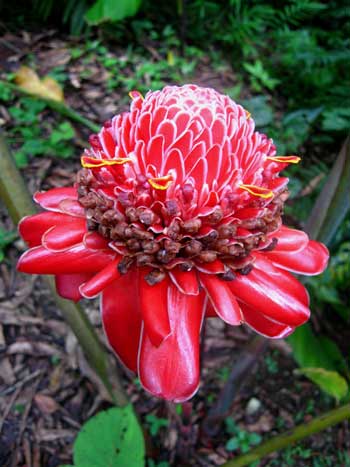 Back on the road, we had only a short drive to the Honduran Border at El Florido, a tiny outpost whose only claim to anything is that it's on the border. We anticipated another smooth crossing, especially since there were few other "customers" and plenty of space to pull over and park, in contrast to our entry into Guatemala.
Back on the road, we had only a short drive to the Honduran Border at El Florido, a tiny outpost whose only claim to anything is that it's on the border. We anticipated another smooth crossing, especially since there were few other "customers" and plenty of space to pull over and park, in contrast to our entry into Guatemala. 
 In the visitors' parking lot, before we even got to the ticket counter, we were stopped in our tracks by the coolest truck Rus had ever seen. It was a double cab Kia, seats six, made in Korea. It had a flat bed with folding sides and rear gate to convert from flatbed to a pickup. Everything was easy-access and unembellished. To top it off, it was diesel and 4-wheel drive! This is exactly the rig Rus was wanting to get when we get back to the U.S., and he was all around and underneath, checking it out. The engine was running, and soon a woman came over and greeted us. We told her how much we admired her truck, and she said how much she loved it, too. Her name was Flavia, a Honduran, who'd lived in Kentucky and raised her family there, and returned here about 7 years ago to manage the hacienda that had been in her family for generations. She asked where we were staying, and when we told her at the Texaco, she said, "Oh, you should come up and stay at my place, and see the ruins tomorrow, they won't be as crowded on Monday."
In the visitors' parking lot, before we even got to the ticket counter, we were stopped in our tracks by the coolest truck Rus had ever seen. It was a double cab Kia, seats six, made in Korea. It had a flat bed with folding sides and rear gate to convert from flatbed to a pickup. Everything was easy-access and unembellished. To top it off, it was diesel and 4-wheel drive! This is exactly the rig Rus was wanting to get when we get back to the U.S., and he was all around and underneath, checking it out. The engine was running, and soon a woman came over and greeted us. We told her how much we admired her truck, and she said how much she loved it, too. Her name was Flavia, a Honduran, who'd lived in Kentucky and raised her family there, and returned here about 7 years ago to manage the hacienda that had been in her family for generations. She asked where we were staying, and when we told her at the Texaco, she said, "Oh, you should come up and stay at my place, and see the ruins tomorrow, they won't be as crowded on Monday." 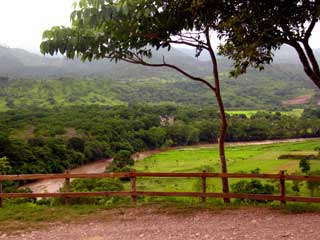 She wasn't sure she had enough level space for us to park, though, so she gave us a ride there in her cool truck to see. We crossed the river and drove up into the hills above Copan, to a gorgeous property with expansive views of the river winding through an emerald green valley, the ruins visible below through the forest on the opposite bank, and the town in the distance. Flavia has created a lovely and charming b&b/resort/retreat center there; the Hacienda San Lucas. Some of the buildings were very old, adobe and plaster with tile roofs, one was even built on the stone foundations of an earlier Mayan building. The newer buildings kept with the same architecture. We went through her ancient kitchen with its open-fire stove into the outdoor eating area, where she asked her cook to bring us a delicious home-made jamaica (hibiscus) drink, and we had a nice visit while she told us the story of the property and how she'd come to be there and create a new life for herself. We found a patch of ground that we thought our hydraulic jacks might bring close to level, and decided to stay, especially since she also offered laundry service and access to a real bathroom and hot showers!
She wasn't sure she had enough level space for us to park, though, so she gave us a ride there in her cool truck to see. We crossed the river and drove up into the hills above Copan, to a gorgeous property with expansive views of the river winding through an emerald green valley, the ruins visible below through the forest on the opposite bank, and the town in the distance. Flavia has created a lovely and charming b&b/resort/retreat center there; the Hacienda San Lucas. Some of the buildings were very old, adobe and plaster with tile roofs, one was even built on the stone foundations of an earlier Mayan building. The newer buildings kept with the same architecture. We went through her ancient kitchen with its open-fire stove into the outdoor eating area, where she asked her cook to bring us a delicious home-made jamaica (hibiscus) drink, and we had a nice visit while she told us the story of the property and how she'd come to be there and create a new life for herself. We found a patch of ground that we thought our hydraulic jacks might bring close to level, and decided to stay, especially since she also offered laundry service and access to a real bathroom and hot showers! 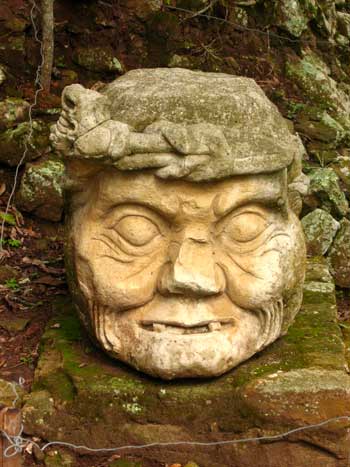 Early next morning we went back to the ruins, deciding this time to hire a guide, and boy are we glad we did. The guides here are very educated, organized into their own association, and are regularly briefed by the scholars and archeologists who study Copan. Our guide, Rodolfo, Tito for short, spoke excellent English, but amazingly had never lived outside Honduras. The depth of his knowledge was impressive. As we walked the ruins we hammered him with our questions and he was never at a loss, whether it was an item of history, social structure, archeology, or botany. A reminder to Rus, because he never wants to: hire a guide. We're tourists in these places, and we don't know squat, so why not give the locals some business and learn more at the same time?
Early next morning we went back to the ruins, deciding this time to hire a guide, and boy are we glad we did. The guides here are very educated, organized into their own association, and are regularly briefed by the scholars and archeologists who study Copan. Our guide, Rodolfo, Tito for short, spoke excellent English, but amazingly had never lived outside Honduras. The depth of his knowledge was impressive. As we walked the ruins we hammered him with our questions and he was never at a loss, whether it was an item of history, social structure, archeology, or botany. A reminder to Rus, because he never wants to: hire a guide. We're tourists in these places, and we don't know squat, so why not give the locals some business and learn more at the same time? 
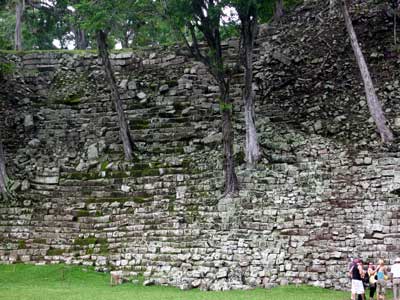 The ruins at Copan are grouped in clusters, and elaborately decorated with sculpture and stelae. These at left are unrestored.
The ruins at Copan are grouped in clusters, and elaborately decorated with sculpture and stelae. These at left are unrestored. 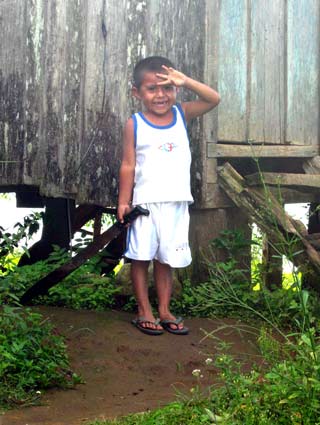 Arriving on the coast after a beautiful drive through the aforementioned country, before Rus got sidetracked with machetes, we found a beautiful place to camp on the beach for a couple of nights, an actual rv park called Pelican's Beat, a few kilometers outside La Ceiba, owned by a Honduran woman and her French/Quebeqois husband. The husband was away in Canada, his wife and her mother were running the place, and boy, were they surprised to see us. We don't think they'd had anyone there for several months. People don't travel here in the rainy season, but we can't understand why. Sure, it rains a lot, sometimes every day, but only in the late afternoons or evenings. The rest of the time the weather's fine, and the countryside is so lush and green, we carry a machete, too!
Arriving on the coast after a beautiful drive through the aforementioned country, before Rus got sidetracked with machetes, we found a beautiful place to camp on the beach for a couple of nights, an actual rv park called Pelican's Beat, a few kilometers outside La Ceiba, owned by a Honduran woman and her French/Quebeqois husband. The husband was away in Canada, his wife and her mother were running the place, and boy, were they surprised to see us. We don't think they'd had anyone there for several months. People don't travel here in the rainy season, but we can't understand why. Sure, it rains a lot, sometimes every day, but only in the late afternoons or evenings. The rest of the time the weather's fine, and the countryside is so lush and green, we carry a machete, too! 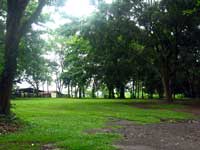 Catarata de Pulhapanzak
Catarata de Pulhapanzak



